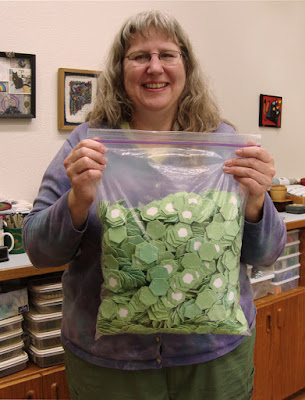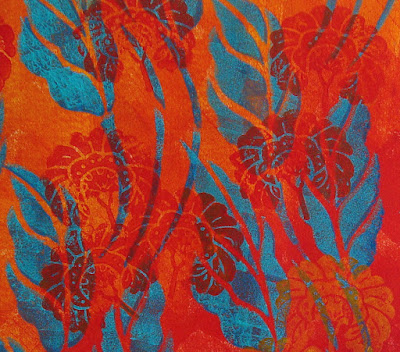It All Started with Hexie-lust!
Look back to early 2012, when my dear friend, Christy, started covering little hexagon-shaped bits of card stock with fabric, making stacks of 6 ready to sew together as petals for a hexie flower. While I was working on a beading project, she was making these utterly irresistible stacks of hexies, until finally I succumbed to the temptation, and joined her.
Here is Christy holding a whole bag of covered hexie shapes, made for the pathway around her hexie flowers.
And here I am holding my hexie quilt, showing the final seam of hand stitching needed to complete the quilt top for my hexie quilt, Grandma's Flower Garden.
You'd think that hand-stitching and quilting over 4,000 hexies would be enough for any sane person, right?
Guess I'm not sane, because in 2015 I started another hexie quilt, or as it turns out, a triptych of wall quilts, for which I've completed 733 hexie flowers (which requires 5,131 individual hexies)!
Getting Hooked on Crochet
OK.... so now, I'm finished with hexies, right? You guessed it! The answer is, "NO WAY." And once again it's Christy's "fault." With her hexie quilt on the back burner for a while, she moved into a crochet phase, making lovely afghans and shawls. She, along with Sabine, my friend in Germany, got me hooked on crochet (pun intended).
This is the first shawl I made late in 2015, learning and getting comfortable with the hook.
Then.... the big bang happened... the crochet-hexie connection!!! This is it. I saw this picture on Huib Petersen's Facebook page, fell bonkers in love, messaged him to find out about it, and learned that there is a pattern for the flowers online. Click on the above photo of Huib's flowers to see it enlarged... Wouldn't you be a bit inclined to go bonkers over it too???
On June 12, 2016, just one day after seeing his crocheted hexie flowers on Facebook, Christy and I were in Island Wools, our local yarn shop, buying DK-weight, cotton yarn in a dozen colors, ready to begin our own stacks of crocheted hexie flowers!
On a whim, right there in the yarn shop, we decided to keep what we were doing a secret... not to show or tell anybody about our project until we finished our afghans... no blogging or posting on Facebook about it. We didn't even tell Libby or Julie at the yarn shop why we kept ordering more cotton yarn. Our secret-keeping made it all the more fun!
On a whim, right there in the yarn shop, we decided to keep what we were doing a secret... not to show or tell anybody about our project until we finished our afghans... no blogging or posting on Facebook about it. We didn't even tell Libby or Julie at the yarn shop why we kept ordering more cotton yarn. Our secret-keeping made it all the more fun!
Original Crochet-Along, Frida's Flowers
According to Huib, the instructions for his flowers came from a Stylecraft, Crochet-Along, called Frida's Flowers, staring an original pattern by Jane Crowfoot.
This is a photo from the instructions, showing the finished afghan, which includes several identical flowers in each of 2 simple and 5 complex designs. All of the designs are are multi-colored and textural, with raised flower parts, enough to make us drool!
Bored with making 6 identical flowers - Colors calling us!
Our plan was to get together at my house every Sunday afternoon to crochet hexie flowers, each of us completing enough flowers to make an afghan. In a little over a year of working 4-6 hours nearly every Sunday and some Tuesday evenings as well, we each had completed 39 flower blocks and 6 half-flower blocks, and were ready to crochet them together.
Ooops... I'm getting ahead of myself with this story. We began with this block, called Rosa, which was the 3rd block in the overall design. (Blocks 1 and 2 are the more simple ones with a small central bud and plain background). This one is the easiest of the full flower designs.
But, for both of us, it was difficult, as there were several stitches we didn't know. Thanks to Youtube videos, we were able to learn them. However, after making two flowers each in the pattern colors, partially out of boredom and partly because of the influence of Huib's multi-color, no-two-the-same flowers, we decided to pick our own colors, making only a pair in each colorway. This, of course, caused us both to buy a lot more colors of yarn... oh for fun!
After making 6 each of Blocks 3 and 4, mine looked like this. Christy's color choices are different... enough different that our finished afghans may look like sisters, but definitely not like identical twins.
I started looking at flower catalogs to find new color combinations... and both of us were buying yarn like crazy. Some brands have more that 50 color choices in DK-weight cotton. I admit to spending over two hundred dollars on yarn all-in-all, with some remainders for future projects. Never mind the cost... I adore all the colors.
Designing Our Afghans
Early in the process, both Christy and I decided we wanted to make something more like Huib's, with a random or nearly random placement of the blocks. Plus, we wanted it to be a bit bigger than the 31-block original design.
Also, we didn't want to include any of the more simple blocks, except as modified half-blocks for the sides.
A year went by, with the two of us continually challenged, thoroughly enjoying the process of making our blocks. Then it was time to lay them all out!
Almost at once, it was clear that the flowers needed more space, more black around each one to set them off. So, before crocheting them together, we bought more skeins of black yarn, and added a row of double crochet around each of the blocks. This also would add a bit more to the size of the afghans, making them large enough to cover both arms and legs while watching a good movie on a winter's evening.
Here is my finished arrangement, the hexie flower blocks crocheted together with a slip-stitch, awaiting a border. Although the original design included a border that would have worked OK, by then I was flying solo, wanting a border I could call my own.
After some experimentation, trial-and-error, crochet and un-ravel attempts, this is my final border invention, which includes the "popcorn" stitch, central to many of the flowers. It was challenging to figure out how to crochet the increases and decreases necessary for the zig-zag edges on the sides, and still keep it flat. Again, trial-and-error was part of the process.
Here is my almost-finished afghan, my own version of Frida's Flowers, showing the size!
Entering at the San Juan County Fair
As we neared completion, we faced a moral dilemma, a difficult decision. We both enjoy submitting entries at our local San Juan County Fair each year, especially in the Fiber and Textile Arts Divisions. These entries are judged and eligible to win ribbons and cash prizes. In previous years, there haven't been many crocheted items entered, nothing that has won any of the top awards.
We figured our afghans could be "game changers," that they had a chance of winning. But we didn't like the idea of being in competition with each other for the top awards, the Best of Class and the Best of Show. If we both entered, neither quilt would win a top award, or one would win and the other wouldn't (which might be the worst outcome). So, after some heartfelt discussions, we decided I would enter mine this year, and she would delay finishing hers until later so that it would be eligible to enter next year.
Here's what happened... Best of Class and Viewer's Choice for me in 2017!!!! And hopefully, the same will happen next year for Christy's version. Twelve months from now, I know for sure all the attendees will have forgotten my quilt, and will love seeing Christy's flowers, just as they did mine this year!
































































